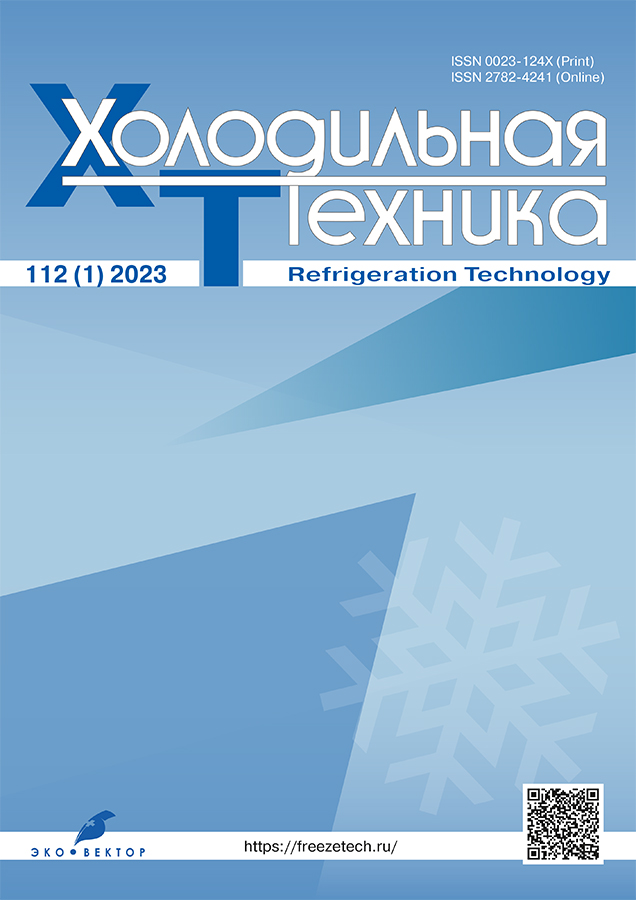Substantiation of the possibility of gas liquefaction in oil–free low–speed refrigeration compressors
- 作者: Busarov S.S.1, Nedovenchany A.V.1, Kapelyukhovskaya A.A.1
-
隶属关系:
- Omsk State Technical University
- 期: 卷 112, 编号 1 (2023)
- 页面: 21-27
- 栏目: Original Study Articles
- URL: https://freezetech.ru/0023-124X/article/view/513731
- DOI: https://doi.org/10.17816/RF513731
- ID: 513731
如何引用文章
详细
BACKGROUND: Existing refrigeration machines contain four main units, i.e., compressor, condenser, expander, and evaporator that perform the refrigeration cycle. Currently, the liquefaction of the refrigerant occurs in the condenser. The creation of the conditions under which condensation of the working fluid would occur in the compressor unit would make the development of a compact refrigeration machine possible by eliminating the condenser from it.
AIMS: This work aims to investigate the possibility of creating a compact refrigeration machine with the implementation of the condensation process of the working fluid in the compression chamber of the compressor.
MATERIALS AND METHODS: The object of the study is a low–speed compressor, in which the pressure ratio significantly exceeds known analogs and simultaneously the temperature is significantly lower than that of high–speed machines because of the creation of conditions under which compression occurs with polytropic indicators below 1.08. The research method involves determining the gas temperature at critical pressure and comparing the obtained result with the critical temperature. The system of equations and assumptions used relates to the model with lumped parameters of the working fluid.
RESULTS: The results obtained on the compression of such refrigerants as ammonia, carbon dioxide, R12, R22, and Freon–134a showed the possibility of obtaining the required pressures in a low–speed machine at temperatures significantly below the critical temperature.
CONCLUSIONS: This work examines and proposes to study further those working fluids of refrigeration machines that can go into the liquid phase in a low–speed compressor unit because of their characteristics and operating parameters in the refrigeration machine. Further experimental confirmation of this will enable partial or complete elimination of the condenser unit in the refrigeration machine.
全文:
作者简介
Sergey Busarov
Omsk State Technical University
编辑信件的主要联系方式.
Email: bssi1980@mail.ru
ORCID iD: 0000-0001-8894-0547
SPIN 代码: 4141-3733
Cand. Sci. (Tech.), Associate Professor
俄罗斯联邦, OmskAlexey Nedovenchany
Omsk State Technical University
Email: lonewolf_rus88@mail.ru
ORCID iD: 0000-0002-9691-5904
SPIN 代码: 1945-2942
Cand. Sci. (Tech.), Associate Professor
俄罗斯联邦, OmskAlexandra Kapelyukhovskaya
Omsk State Technical University
Email: shipunovaa@mail.ru
ORCID iD: 0009-0007-4613-701X
SPIN 代码: 2410-8153
Senior Lecturer
俄罗斯联邦, Omsk参考
- Yusha VL, Busarov SS, Gromov AYu. Assessment of the Prospects of Development of Medium–Pressure Single–Stage Piston Compressor Units. Chemical and Petroleum Engineering. 2017;53:7–8. doi: 10.1007/s10556–017–0362–2
- Yusha VL, Busarov SS, Goshlya RYu, et al. The experimental research of the thermal conditions in slow speed stage of air reciprocating compressor. Procedia Engineering. 2016;152:297–302. doi: 10.1016/j.proeng.2016.07.706
- Yusha VL, Busarov SS. Prospects for the creation of low–flow compressor units of medium and high pressure based on unified low–speed long–stroke stages. Nauchno–tekhnicheskie vedomosti SPbPU. Estestvennye i inzhenernye nauki. 2018;24(4):80–89. (In Russ). doi: 10.18721/JEST.24408
- Yusha VL, Karagusov VI, Busarov SS. Modeling the operating processes of low–speed, long–stroke piston compressors. Khimicheskoe i neftegazovoe mashinostroenie. 2015;3:21–24.
- Busarov SS, Goshlya RYu, Gromov AYu, et al. Mathematical modeling of heat transfer processes in the working chamber of the low–speed stage of a piston compressor. Kompressornaya tekhnika i pnevmatika. 2016;6:6–10. (In Russ).
- Yusha VL, Dengin VG, Busarov SS, et al. The estimation of thermal conditions of highly–cooled long–stroke stages in reciprocating compressors. Procedia Engineering. 2015;113:264–269. doi: 10.1016/j.proeng.2015.07.333
- Yusha VL, Karagusov VI, Busarov SS. Modeling the work processes of slow–speed, long–stroke piston compressors. Chemical and Petroleum Engineering. 2015;51(3–4):177–182. doi: 10.1007/s10556–015–0020–5
- Gromov AYu. Razrabotka porshnevykh stupeney s lineynym privodom dlya maloraskhodnykh kompressornykh agregatov i issledovanie ikh rabochikh protsessov [dissertation] Omsk; 2017.(In Russ).
- Yusha VL, Busarov SS, Nedovenchanyi AV, et al. Analysis of the temperature state of an intensively cooled long–stroke low–speed stage of a piston compressor. Khimicheskoe i neftegazovoe mashinostroenie. 2016;9:11–8. (In Russ).
- Busarov SS, Gromov AYu, Busarov IS, et al. Modernization of methods for calculating heat transfer processes in the working chamber of an air single–stage low–speed piston compressor of medium pressure based on experimental studies. Kompressornaya tekhnika i pnevmatika. 2017;3:14–18. (In Russ).
- Busarov SS, Yusha VL, Nedovenchanyi AV. Experimental Evaluation of the Efficiency of Long–Stroke, Low–Speed Reciprocating Compressor Stages in Compression of Different Gases. Chemical and Petroleum Engineering. 2018;54(4):593–597. doi: 10.1007/s10556–018–0520–1
- Plastinin PI. Piston compressors. Vol. 1. Theory and calculation. 2nd ed., revised. and additional Moscow: Kolos; 2006. (In Russ).
- Fotin BS. Rabochie protsessy porshnevykh kompressorov [dissertation] Leningrad; 1974. (In Russ).
- Yusha VL. Cooling and gas distribution systems for volumetric compressors. Novosibirsk: Nauka; 2006. (In Russ).
- Chrustalev BS, Zdalinsky VB, Bulanov VP. A Mathematical Model of Reciprocating Compressor With One or Several Stages for the Real Gases. In: International Compressor Engineering Conference. ICEC; 1996:1108. Accessed: 27.06.2023. Available from: http://docs.lib.purdue.edu/icec/1108
- Frenkel MI. Piston compressors. Theory, structures and design fundamentals. 3rd ed., revised. and additional. Leningrad: Mashinostroenie; 1969. (In Russ).
补充文件













